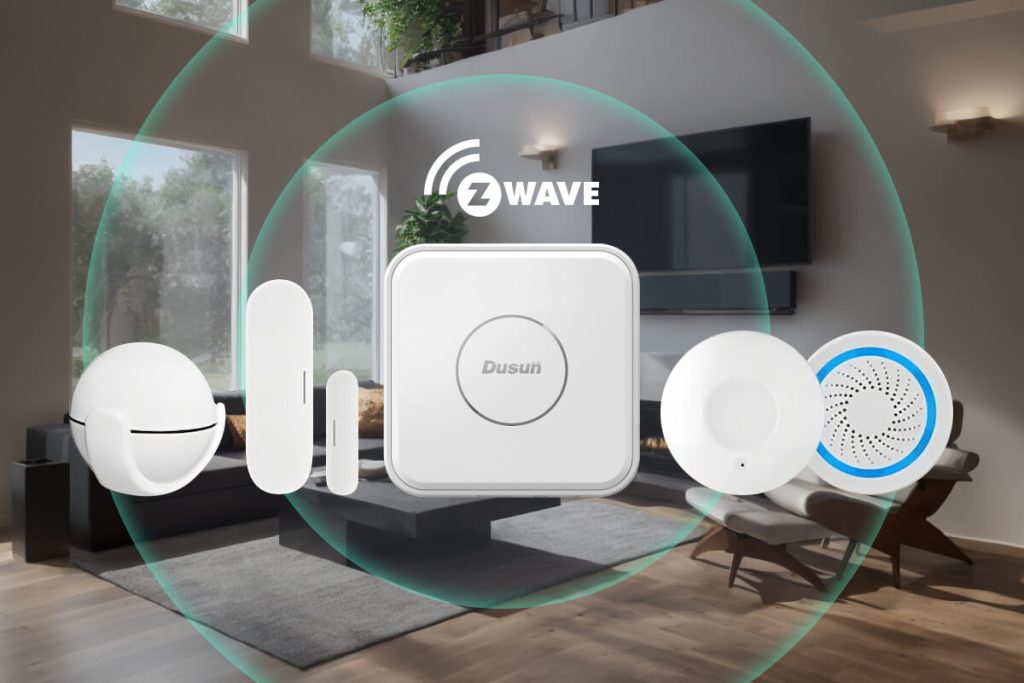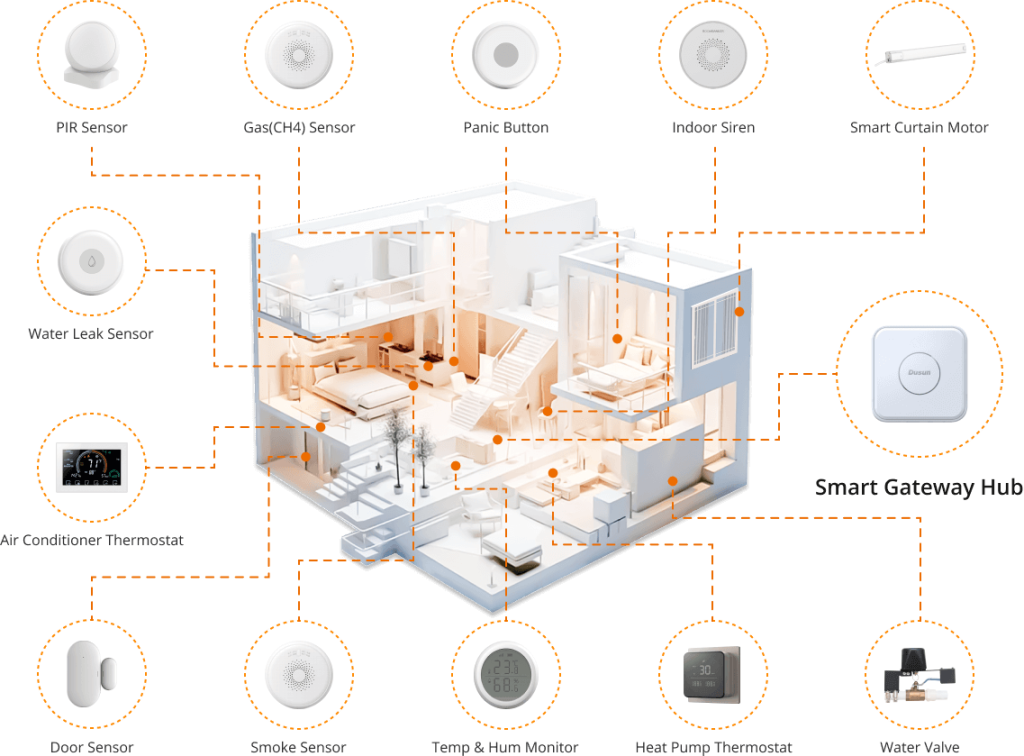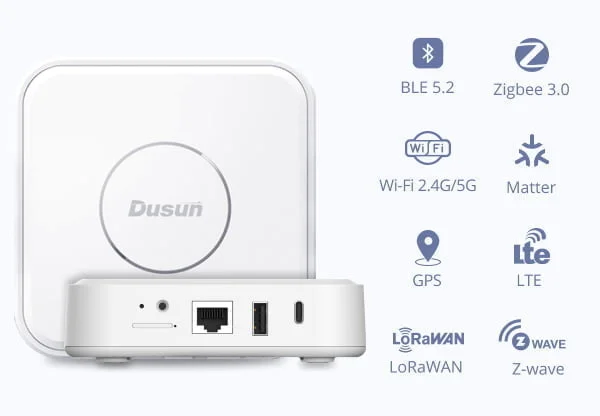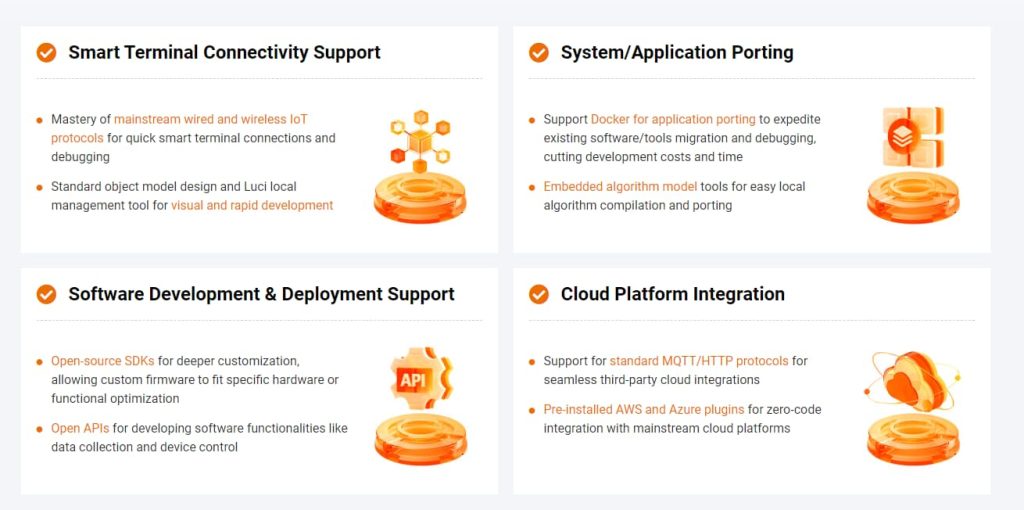Z-wave smart home hub can provide you with a better experience in automating your home and managing these devices safely and reliably. In this article, we will take you through the basics of smart home hubs, and the advantages of Z-Wave technology over other wireless technologies before showing you how to build one. We also assess building versus buying solutions as well as features of Dusun’s high-performance Z-Wave gateways that could be used to support your smart home projects. Among its various Internet of Things (IoT)devices, Dusun has developed advanced programmable Z-Wave gateways for smart home brands, solution providers, and integrators who want to achieve success in their operations. This reading will help you know everything about the starting point for your journey towards having a smart home!
What is a smart home hub?
Smart home hubs are central devices that link together all kinds of connected devices within a place so that they communicate seamlessly and can be controlled correctly. Often they work on multiple protocols which would include Zigbee, Z-Wave, and Wi-Fi making them compatible with an extensive range of gadgets. Thus when acting as the central control points for the entire system in place at homes; it becomes possible to increase the performance as well as interoperability aspects within these automation systems while giving users access from one place.

Why a Z-Wave Hub for Smart Homes?
Z-Wave technology is a popular choice for smart home enthusiasts and professionals alike. Here’s a closer look at what makes Z-Wave a top pick:
- Reliability: Z-Wave ensures your smart home devices work together without a hitch. Its low-frequency signal cuts through interference from other wireless networks, so your devices stay connected and responsive.
- Range: Thanks to Z-Wave’s clever mesh network, every device helps boost the signal, allowing you to cover every inch of your home. Even devices located far from the hub stay connected, so you don’t have to worry about dead zones.
- Interoperability: Z-Wave supports a vast range of devices from various brands, letting you create a smart home system that mixes and matches products seamlessly.
- Security: Z-Wave technology features strong security measures, including AES-128 encryption, to keep your smart home network safe and your data secure.
- Market Trends: As smart home technology grows in popularity, Z-Wave hubs are becoming increasingly sought-after. The latest trends highlight a push for better device interoperability, enhanced security, and energy efficiency, driving the demand for versatile and capable smart home hubs.
How to Build a Z-Wave Smart Home Hub
Building a Z-wave smart home hub involves numerous key steps and challenges. This section will briefly guide you on building your own Z-wave smart home hub.
Key Considerations for Building Your Z-Wave Smart Home Hub
When you’re setting up your Z-Wave smart home hub, there are a few important things to think about to make sure you end up with a great system:
- How Many Devices? Think about how many smart devices you’ll want to control. This will help you decide how powerful your hub needs to be and what kind of features you should include.
- Coverage Matters: Consider all the spaces in your home where you want smart devices to work, from your living room to your backyard. Make sure your hub’s design can provide strong and reliable coverage throughout your entire home.
- Budget vs. Features: Find the right balance between what you want your hub to do and how much you’re willing to spend. You’ll need to weigh the costs of different components against the features you want for your hub.
- Z-Wave Certification: Make sure the devices you plan to use are Z-Wave certified. This certification ensures that your hub will work well with a wide range of Z-Wave devices and maintain a stable connection.
- Think About Future Needs: Plan for how your hub will work with other systems and protocols, like Zigbee or Wi-Fi. A flexible design will help you adapt to future needs and expand your smart home setup.
Steps to Build Z-Wave Smart Home Hub
Building a Z-Wave smart home hub involves several key steps. Here’s a simple guide to get you started:
- Define Your Hub’s Purpose and Features: Decide what you want your hub to do. Think about what devices it needs to support, how user-friendly it should be, and what security features are necessary.
- Choose the Right Hardware: Pick out the essential components, such as the Z-Wave module, microcontroller, power supply, memory, and any extra sensors or interfaces you might need for your hub.
- Assemble a Prototype: Put together a basic version of your hub using the chosen components. This step includes soldering connections and making sure all parts fit and work together. Early testing will help you spot and fix any issues.
- Set Up Basic Firmware: Write the initial firmware to make sure the microcontroller and Z-Wave module communicate effectively. This includes setting up device pairing, data transmission, and the user interface.
- Test and Refine: Check that everything works as planned. Test for performance, reliability, and security. Make any necessary adjustments to ensure all components work seamlessly together.
- Prepare for Mass Production: Finalize the design for large-scale manufacturing. Source components in bulk, set up production processes, and establish quality control measures. Plan for customer support and distribution to get your hub into the market.
Essential Hardware Components for Your Z-Wave Smart Home Hub
When building a Z-Wave smart home hub, selecting the right hardware components is key to creating a reliable and efficient system. Here’s a breakdown of what you’ll need:
1. Z-Wave Gateway/Module
The Z-Wave gateway or module is the heart of your hub. It’s responsible for managing communication between your hub and all Z-Wave devices in your smart home network. Think of it as the central command center where you control and monitor your Z-Wave-enabled devices.
2. Processor/CPU
The processor is like the brain of your smart home hub. It handles everything from processing data to executing commands. You’ll want a processor that can efficiently manage multiple tasks at once to keep your smart home running smoothly.
You may interested in: MCU vs. SoC vs. MPU For IoT Devices: Factors To Consider When Selecting The Brains For IoT Devices
3. Memory
Memory is crucial for your hub’s performance. RAM helps the hub run its operating system and applications, while storage holds firmware, user settings, and device data. Make sure you choose enough memory for both current needs and future growth.
4. Power Supply
A reliable power supply keeps your hub running without interruptions. It needs to meet the voltage and current requirements of all your components. Consider a power supply with battery backup or an uninterruptible power supply (UPS) to ensure your hub stays operational during power outages.
5. Enclosure
The enclosure protects all the internal components of your hub. It should be durable, allow for heat dissipation, and be easy to maintain. Plus, it should look good since it will likely be in a visible spot in your home.
6. Connectivity Options
To accommodate different network setups and user preferences, your hub should offer various connectivity options. Ethernet provides a stable wired connection, while Wi-Fi offers flexibility. Additional options like Bluetooth or cellular can enhance your hub’s versatility and ensure it connects seamlessly with a wide range of devices.
You may interested in: Zigbee Vs Z-Wave: Which is Better for Home Automation
Challenges in Building a Z-Wave Smart Home Hub
- Compatibility Issues: Ensuring interoperability with various Z-Wave devices from different manufacturers requires extensive testing and validation to guarantee seamless operation.
- Hardware Integration: Integrating components like the Z-Wave module, processor, memory, power supply, and connectivity options involves careful consideration of electrical, thermal, and spatial constraints, often requiring iterative prototyping and testing.
- Cost Management: Balancing performance and cost is crucial. High-performance components increase costs, while cheaper ones may compromise reliability. Strategic decisions are needed to deliver a quality product within budget.
- Time to Market: Accelerating development without compromising quality is essential. Quick turnaround times are needed to stay competitive, but rushing can lead to quality issues. Efficient project management and agile practices are key to balancing speed and quality.
You may interested in: Crafting Raspberry Pi Smart Home Hubs, Is It A Good Option to Build at Scale?

Build or Buy a Z-Wave Smart Home Hub?
When it comes to choosing between building your own Z-Wave Smart Home Hub or buying a ready-made one, it’s not always a straightforward decision. Here’s a simple guide to help you weigh the pros and cons of each option.
Building In-House
Pros:
- Customization: Building your IoT hub means you can design it exactly how you want. From hardware features to software functions, you have full control to create something that fits your vision and needs perfectly.
- Intellectual Property: If you build it yourself, all the designs, patents, and technology are yours. This can be a big advantage for your business, giving you control and potentially opening up new opportunities.
- Flexibility: You have the freedom to adapt and change the design based on feedback or new trends. You’re not stuck with someone else’s idea of what a smart home hub should be.
Cons:
- High Costs: Designing and building a hub from scratch is expensive. You’ll need to invest in components, skilled engineers, and testing, which can add up quickly.
- Time-Consuming: The whole process, from brainstorming to creating a final product, takes a lot of time. This can slow down your market entry and make it harder to keep up with fast-changing tech.
- Resource Demands: Building in-house means managing a team of experts and dealing with the complexities of the development process. It’s a big commitment of time and effort.
Buying Off-the-Shelf Solutions
Pros:
- Cost-Effective: Ready-made hubs are usually cheaper than building your own. You benefit from economies of scale and established manufacturing processes.
- Quick Deployment: Off-the-shelf solutions are available right away, so you can get your product to market faster and make the most of current trends.
- Proven Reliability: These products have been tested and come with support, warranties, and certifications. You’re getting a reliable solution with a track record.
Cons:
- Limited Customization: You might not find a hub that matches all your specific needs. Custom features or unique designs could be off-limits.
- Dependence on Third Parties: Relying on an external vendor means you have less control over future updates and quality. You’re at the mercy of their decisions and timelines.
Hybrid Approach
Pros:
- Best of Both Worlds: A hybrid approach lets you mix and match. You can use pre-built components for standard functions and customize parts of the design for your unique needs.
- Cost Efficiency: This method can be less expensive than building from scratch and still allows for some level of customization.
- Faster Time to Market: Combining existing components with custom development can speed up the process, getting your product to market more quickly.
Cons:
- Complex Integration: Putting together custom and off-the-shelf parts can be tricky. You’ll need to carefully plan and test to make sure everything works together.
- Partial Customization: While you can make some tweaks, you won’t have the same level of control as you would with a fully in-house solution.
Making the Decision
When deciding whether to build, buy, or go hybrid, consider both the costs and the strategic fit for your business:
- Financial: Think about the initial investment and ongoing costs for each option. Building in-house involves a big upfront cost but could lead to more significant long-term benefits. Buying a pre-made solution is cheaper initially but might lack the customization you want.
- Strategic: Reflect on your company’s goals. Do you need complete control and the potential for new IP, or do you need to get something to market quickly and cost-effectively? A hybrid approach might offer a balanced solution.
Best Programmable Z-Wave Gateway for Building a Smart Home Hub
If you’re looking for a powerful and flexible Z-Wave gateway to build your smart home hub, Dusun’s DSGW-210 is a standout choice. Here’s why it might be the perfect fit for your next project:
Why does DSGW-210 Edge Computing GatewayStands Out?

- Top-Notch Performance: The DSGW-210 Edge Computing Gateway is powered by a high-performance Quad-core processor, giving you the edge computing power you need for smooth and efficient smart home management.
- Multi-Protocol Support: It’s not just about Z-Wave. This gateway integrates Z-Wave with other popular protocols like Zigbee, Wi-Fi, Bluetooth, and LTE. This means you can connect a wide range of devices and systems all from one hub.
- High Connectivity Options: With support for Wi-Fi 2.4G/5G, Bluetooth 5.2, Zigbee 3.0, and LTE CatM1, Cat1, and Cat4, you have plenty of options for getting your smart home network up and running.
- Robust Hardware: The DSGW-210 comes with up to 2GB of RAM, 32GB of eMMC storage, a USB 2.0 port, and both WAN/LAN network ports. Plus, it has a 5000mAh Li-ion battery for backup power, keeping your hub running smoothly even during outages.
- Versatile Operating Systems: It supports Debian 11, Ubuntu 20.04, Android 11, and Yocto 4.0. This variety allows you to choose the OS that best fits your software needs.
- Security: With hardware encryption (ECC608B), DSGW-210 keeps your data safe and secure.
Customization for Your Needs
Dusun’s Z-Wave gateways are all about flexibility:
- Modular Design: Choose from different configurations to meet your project’s needs. Whether you need LTE, Zigbee, or extra battery backup, you can mix and match to get it just right.
- Scalability: Dusun IoT Gateways offer various RAM and storage options, so you can scale up as your smart home network grows.
- Secondary Development Support: Dusun IoT’s Gateway is a tailored hardware solution specifically designed for enterprise IoT developers. By offering a mature and comprehensive programmable gateway hardware platform, partner’s can easily port or independently develop applications, or modify and conduct secondary development on the underlying firmware based on the open-source SDK. This significantly simplifies the complexities involved in the development of IoT gateways and solutions, reducing the time to market.

Comprehensive ODM Services by Dusun
Dusun offers a range of IoT Product Original Design Manufacturer (ODM) services to help you bring your smart home projects to life:
- Custom Hardware Design: Need something specific? Dusun can tailor the hardware to meet your exact requirements, whether it’s adding new interfaces or designing specialized modules.
- Firmware Development: Get custom firmware to support unique functionalities and applications. Dusun’s team will help develop the features you need.
- Prototype Development: Start with a prototype to test and refine your ideas. Dusun’s rapid prototyping services will help you get your design just right before you move to mass production.
- Manufacturing and Quality Control: From start to finish, Dusun ensures high-quality manufacturing and rigorous quality control to deliver reliable products.
Dusun’s Z-wave Gateways
Discover the comprehensive range of programmable Z-Wave gateways offered by Dusun IoT. These gateways are designed to enhance your smart home automation with robust security, extensive customization options, and seamless integration capabilities. From advanced features like Z-Wave Plus V2 support and all-in-one controller hubs to strong technical support and ODM services, Dusun IoT provides everything you need for building a smart, connected home. For more details and to select the Z-Wave gateway that suits your needs, visit the Dusun Z-Wave Gateway page.

Key takeaways
- Smart home hubs act as the central control unit, managing and integrating various smart home devices for seamless operation.
- Z-Wave technology offers dependable performance, extended range through its mesh network, and robust security for smart home systems.
- To build a Z-Wave hub, you need to define your objectives, select appropriate hardware, create a prototype, test it extensively, and then plan for mass production.
- Choosing between building in-house or buying an off-the-shelf solution involves weighing the costs and benefits: building offers full customization but is expensive and time-consuming, while buying is more affordable and quick but less flexible. A hybrid approach offers a balance of both.
- Dusun’s DSGW-210 Z-Wave gateway stands out with its powerful processor, multi-protocol support, strong security features, and extensive customization options, making it an excellent choice for smart home projects.
Ready to build Z-Wave Smart Home Hub or want to inquire more about our programmable gateway solutions, reach out to us to get started.
FAQs
Can I use a Z-Wave hub for both home automation and security?
Many Z-Wave hubs support both home automation and security features. You can connect devices like smart locks, security cameras, and motion sensors for a complete home security system.
How do I know if a Z-Wave device will work with my smart home hub?
To ensure compatibility, check if the Z-Wave device is Z-Wave certified. Most certified devices will work with any Z-Wave hub. Also, review the device’s specifications and any supported features listed by the manufacturer.


















